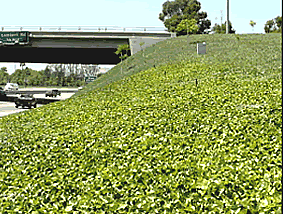Roadside Management Toolbox: Irrigated Ornamental Vegetation


What is This Treatment?
Irrigated ornamental vegetation is typical highway planting with an emphasis on covering or completely shading the ground surface with desirable vegetation to suppress weeds, annual grasses and other undesirable vegetation.
When to Use This Design Concept?
Irrigated vegetation should be considered as a roadside treatment in urban and suburban areas where development of the adjoining roadsides to a higher level of enhancement is warranted due to context sensitivity or political issues. Planting may range from turf or spreading groundcovers to a variety of shrubs and trees, including both native and non-native species. Consult the District Landscape Architect and Maintenance for assistance in determining the suitability of this roadside treatment.
Benefits
- Ornamental planting provides multiple benefits - controlling unwanted vegetation, slope and soil protection, and visual enhancement.
- Properly designed vegetation can screen objectionable views from the highway, reduce headlight glare and help conceal trash.
- Although typical highway planting doesn't significantly affect highway noise, it does reflect less noise than hard surface treatments.
Limitations
- Irrigation systems and ornamental planting require up-front capital costs and intensive on-going maintenance.
- Ornamental planting on highways is limited to warranted areas as defined in the Project Development Procedures Manual.
Specifications
- Use 2010 Standard Specifications section 20, and section 20 Standard Special Provisions (SSPs). Cost
Cost
- $80,000 - $120,000/acre ($16 - $24/yd2) including a 3 year plant establishment period.
- Bees Items – Multiple items
Updated May 24, 2012

